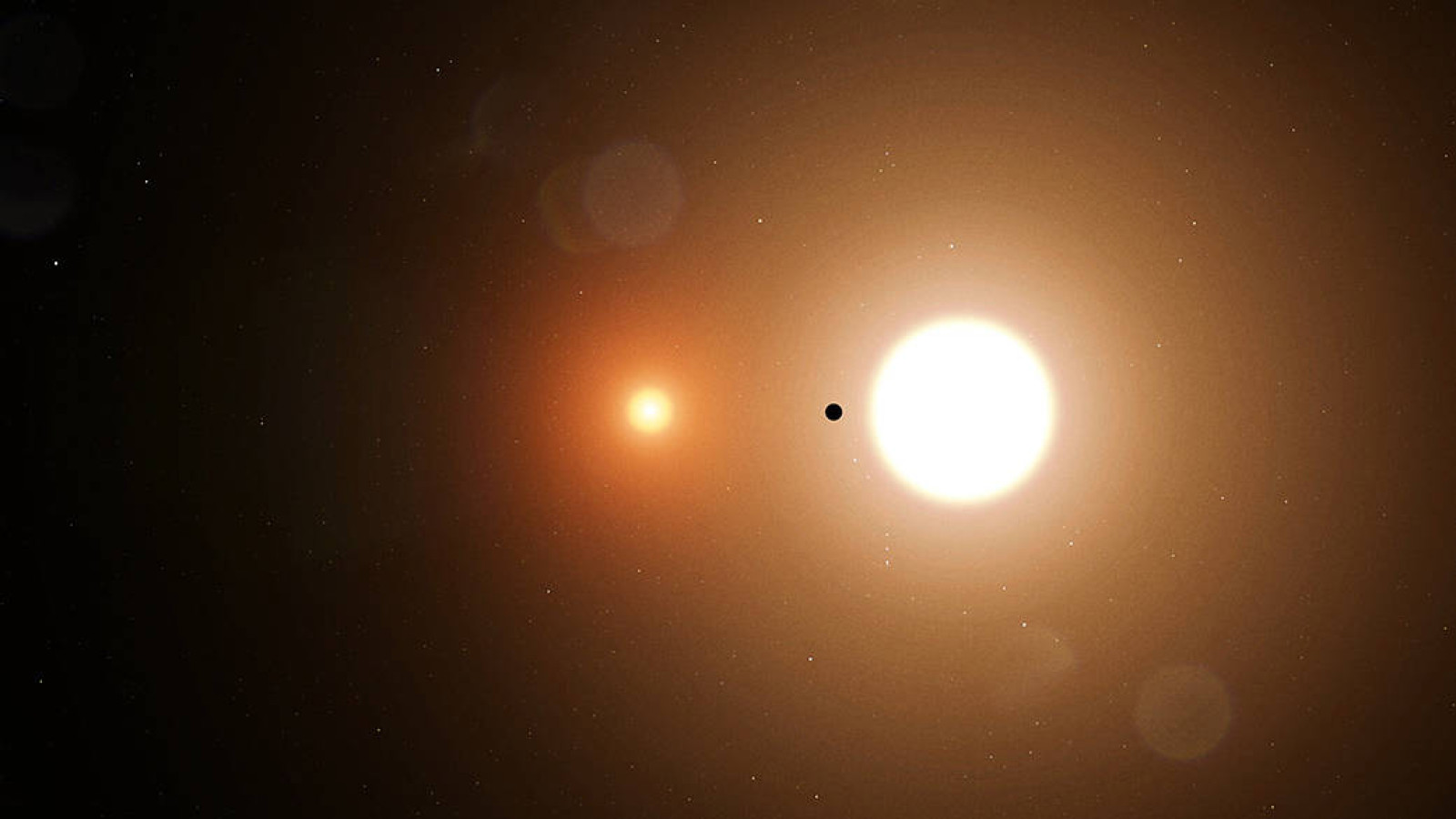5 Minutes
In the vast expanse of the cosmos, our Sun stands as a solitary beacon. However, many stars exist in binary systems, where two stars are gravitationally bound and orbit a common center. In some of these systems, the stars are sufficiently distant from each other, allowing planets to form around each individual star. Conversely, in tight binary systems—where the stars are so close that both would fit comfortably within our Solar System—planets typically orbit at greater distances, encircling both stars in a circumbinary fashion.
Recent scientific observations have unveiled a system that defies these conventional categories. This system features a tight binary configuration with a massive central star orbited by a white dwarf at a distance two to three times that of Earth's orbit around the Sun. Intriguingly, a lone planet has been confirmed to exist within this system, nestled between the two stars and orbiting at a distance comparable to Earth's distance from the Sun. Adding to the peculiarity, this planet orbits in a retrograde direction relative to the white dwarf.
Exploring the ν Octantis System
The exoplanetary system in question is known as ν Octantis (Nu Octantis). Its primary star is slightly more massive than our Sun, with a mass of approximately 1.6 solar masses. This primary star is accompanied by a much dimmer companion, roughly half the mass of the Sun, whose characteristics have only recently been detailed. The companion's orbit around the central star is somewhat eccentric, ranging from about two astronomical units (AU)—the average Earth-Sun distance—at its closest approach to approximately three AU at its farthest. Until recently, the exact nature of this companion star remained uncertain.
Through detailed near-infrared imaging, astronomers aimed to resolve the two stars. The absence of a second object with sufficient brightness in these observations ruled out the presence of a main sequence star, leading to the conclusion that the companion is a white dwarf. However, this white dwarf isn't the only celestial body orbiting the central star of ν Octantis.
Previous studies hinted at the presence of an exoplanet within this system. Yet, the characteristics of its orbit were perplexing, as no stable orbit consistent with observations could be identified. The only clear aspect was that the most stable orbits seemed to necessitate the planet having a retrograde motion—meaning it orbits in the opposite direction to the companion star. This placed ν Octantis firmly in the category of systems requiring further data for clarification.
An international team of scientists addressed this need by conducting nearly two years of additional observations using the HARPS (High Accuracy Radial Velocity Planet Searcher) instrument in Chile. The data unequivocally confirmed the existence of a planet in a retrograde orbit and suggested that the plane of its orbit is inclined by 17 degrees relative to the plane formed by the orbits of the two stars. Unfortunately, modeling variations of this orbit over time indicated that 98% of them would become unstable within 50 million years.
To address this instability, researchers explored a range of orbital properties that would maintain all components within a single plane. This approach yielded a solution where 75% of the modeled orbits remained stable beyond 50 million years, leading researchers to consider this the most plausible description of the system.
In this configuration, the planet in ν Octantis maintains a retrograde orbit, moving opposite to the smaller star in the system. Its orbit is approximately one AU, placing it at a distance from the central star similar to that of Earth from the Sun. However, the orbit is somewhat elliptical, with one segment bringing the planet significantly closer to the central star than the other.
Crucially, the entire orbit of the planet lies within the orbit of the smaller companion star. The gravitational forces in such a tight binary system would typically prevent planets from forming in this region during the system's early history. This raises the question: how did the planet end up in such an unusual configuration?
Unraveling a Complex History
The presence of a white dwarf in the ν Octantis system offers potential explanations for this anomaly. White dwarfs are remnants of Sun-like stars that have undergone a late helium-burning phase, causing them to expand significantly and shed their outer layers. In the context of ν Octantis, this process would have allowed substantial material to be transferred from the outer companion to the surface of what is now the central star, resulting in a significant mass transfer.
This mass transfer could have led to one of two scenarios placing a planet within the system's interior. Firstly, the transferred material might not have immediately accreted onto the nearby star's surface. If the process was gradual enough, it could have formed a protoplanetary disk for a brief period—sufficient to produce a planet within the system's interior.
Alternatively, if planets initially orbited both stars externally, the redistribution of mass within the system could have destabilized their orbits. This instability might have triggered interactions among the planets, causing one to spiral inward and eventually settle into the stable retrograde orbit observed today.
The authors emphasize that either scenario is likely rare, suggesting that we are unlikely to observe many other systems like this at our current stage of exoplanet study. They point to another tight binary system, HD 59686, which appears to host a planet in a retrograde orbit. However, as with ν Octantis, the data is not yet definitive enough to exclude alternative configurations. Thus, the quest for more data continues.
This discovery challenges existing models of planet formation and orbital dynamics, offering a unique opportunity to refine our understanding of planetary systems in binary star environments. As technology advances and observational techniques improve, further studies of systems like ν Octantis will undoubtedly provide deeper insights into the complex processes governing the cosmos.


Comments